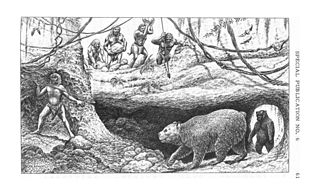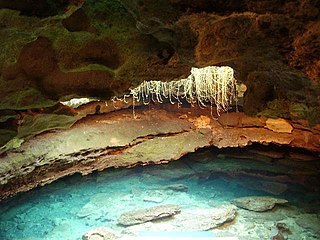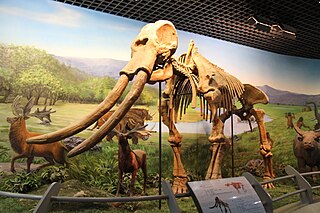Related Research Articles

Bilzingsleben is a former stone quarry in Thuringia, Germany, notable for its wealth of palaeolithic human fossils and artifacts.

The Florida Museum of Natural History (FLMNH) is Florida's official state-sponsored and chartered natural history museum. Its main facilities are located at 3215 Hull Road on the campus of the University of Florida in Gainesville.

Għar Dalam[A] is a 144-metre long phreatic tube and cave, or cul-de-sac, located in the outskirts of Birżebbuġa, Malta. The cave contains the bone remains of animals that were stranded and subsequently became extinct in Malta at the end of the Last Glacial Maximum. It has lent its name to the Għar Dalam phase in Maltese prehistory, and is viewed as one of Malta's most important national monuments. Pottery similar to that found in Stentinello was found at Għar Dalam, but lacking details such as stamp decorations.

Charles Deering Estate was the Florida home of Charles Deering until 1927 when he died at the estate.

Vero Man refers to a set of fossilized human bones found near Vero, Florida, in 1915 and 1916. The human bones were found in association with those of Pleistocene animals. Pleistocene dates range from 2,580,000 to 11,700 years ago. The suggestion that humans might have been present in Florida during the Pleistocene was controversial at the time and most of the contemporary archaeologists did not accept that the Vero fossils could be that old.
The Page–Ladson archaeological and paleontological site (8JE591) is a deep sinkhole in the bed of the karstic Aucilla River that has stratified deposits of late Pleistocene and early Holocene animal bones and human artifacts. The site was the first pre-Clovis site discovered in southeastern North America; radiocarbon evidence suggests that the site dates from 14,200 to 14,550 BP. These dates are roughly 1,000 to 1,500 years before the advent of the Clovis culture. Early dates for Page–Ladson challenge theories that humans quickly decimated large game populations in the area once they arrived.
Robert S. Carr is an American archaeologist and the current executive director of The Archaeological and Historical Conservancy, Inc. He specializes in Southeastern archaeology, with particular emphasis on archaeology in Florida. He has also conducted fieldwork in the Bahamas.

The Warm Mineral Springs is a water-filled sinkhole located in North Port, Florida, a mile north of U.S. 41. The primary water supply is a spring vent deep beneath the pool's water surface. Warm Mineral Springs is the only warm water mineral spring in the State of Florida. It is an important geological and archaeological site containing Native American remnants. The site was operated as a spa from 1946 until 2000. It was added to the U.S. National Register of Historic Places on November 28, 1977. The springs re-opened for swimming only in 2014.

Little Salt Spring is an archaeological and paleontological site in North Port, Florida. The site has been owned by the University of Miami since 1980 with research performed there by the university's Rosenstiel School of Marine, Atmospheric, and Earth Science.

Melbourne Bone Bed is a paleontological site located at Crane Creek in Melbourne, in the U.S. state of Florida. This site contains fossils from the Late Pleistocene period 20,000 to 10,000 years before the present. The fossils include extinct animals such as varieties of camels, dire wolves, Florida cave bears, giant armadillos, giant beavers, giant bison, giant ground sloths, mammoths, mastodons, saber-toothed cats, and tapirs.

Tremarctos floridanus is an extinct species of bear in the family Ursidae, subfamily Tremarctinae. T. floridanus became extinct at the end of the last ice age, 11,000 years ago. It's fossils have been found throughout the Southeastern United States, in northeastern Mexico, and in Belize from the Rancholabrean epoch, and from earlier epochs at some sites in western North America.
The Indigenous peoples of Florida lived in what is now known as Florida for more than 12,000 years before the time of first contact with Europeans. However, the indigenous Floridians living east of the Apalachicola River had largely died out by the early 18th century. Some Apalachees migrated to Louisiana, where their descendants now live; some were taken to Cuba and Mexico by the Spanish in the 18th century, and a few may have been absorbed into the Seminole and Miccosukee tribes.

Devil's Den is formed by a karst window, in which the roof over a subterranean river has collapsed, exposing the water to the open surface, near Williston, Florida. It is privately owned and operated as a SCUBA diving training and recreational facility.

Palaeoloxodon naumanni is an extinct species of elephant belonging to the genus Palaeoloxodon that was native to the Japanese archipelago during the Middle to Late Pleistocene around 330,000 to 24,000 years ago. It is named after the German geologist Heinrich Edmund Naumann who first described remains of the species in the 19th century, with the species sometimes being called Naumann's elephant. Fossils attributed to P. naumanni are also known from China, though the status of these specimens is unresolved, and some authors regard them as belonging to separate species.

Paleontology in Florida refers to paleontological research occurring within or conducted by people from the U.S. state of Florida. Florida has a very rich fossil record spanning from the Eocene to recent times. Florida fossils are often very well preserved.

Fossil Cave (5L81), formerly known as The Green Waterhole, is a cave in the Limestone Coast region of south-eastern South Australia. It is located in the gazetted locality of Tantanoola about 22 kilometres north-west of the city of Mount Gambier, only a few metres from the Princes Highway between Mount Gambier and Millicent. It is popular with cave divers and is notable for being both a unique paleontological site and the "type locality" for very rare crustaceans which to date have been found only in caves and Blue Lake in the Mount Gambier region.

Natural Trap Cave is a pit cave in the Bighorn Mountains, in northern Wyoming, United States. Excavations in the cave are an important source of paleontological information on the North American Late Pleistocene, due to a rich layer of fossils from animals that became trapped in the cave.

The Noisetier Cave, owing its popular name to the Hazel trees that grow in front of its entrance, is located in a mountainside 145 m (476 ft) atop the Vallée d'Aure in the Ardengost commune, Hautes-Pyrénées department in the region Occitania, Southern France. During systematic excavations since 1992 Middle Paleolithic stone tools and artifacts attributed to the Neanderthal Mousterian culture were discovered among numerous faunal remains.
Sheriden Cave is a Paleo-Indian archaeological site from the late Ice age in Wyandot County, Ohio. Glacial deposits sealed off the cave more than 10,000 years ago. Sheriden Cave is a karst sinkhole on a dolomite ridge that crosses Hancock and Wyandot Counties. It is associated with the Indian Trail Caverns that opened in 1927. Sheriden Cave was discovered in 1989. The cave is unique because in addition to stone tools, there were also bone tools, remains of extinct animals, and organic matter found in the cave. Radiocarbon dating of artifacts indicate that they were used 11,000 and 12,000 years ago.
Torontoceros was an extinct genus of deer, nicknamed the Toronto subway deer. It lived in the Late Pleistocene in Ontario while likely being native elsewhere. The sole species is T. hypogaeus.
References
- Carr, Robert S. (March 28, 1986a). "Sinkhole Yields Rare View of Dade's Past". The Miami News. p. 13A. Retrieved 24 January 2013.
- Carr, Robert S. (September 1986b). "Preliminary Report on Excavation at the Cutler Fossil Site (8DA2001) in Southern Florida". The Florida Anthropologist. 39 (3 Part 2): 231–232. Retrieved 16 January 2013.
- Carr, Robert S. (2012). Digging Miami. Gainesville, Florida: University Press of Florida. ISBN 978-0-8130-4206-0.
- Martinez, Ricardo (March 28, 1986). "Cutler fossil pit contains cross section of 12,000 years in Dade history". The Miami News. p. 1A. Retrieved 24 January 2013.
- Wheeler, Ryan J., Southern Florida Sites Associated with the Tequesta and their Ancestors (PDF) (NRHP Documentation Form), Florida Division of Historical Resources, retrieved 16 January 2013
